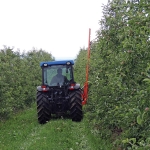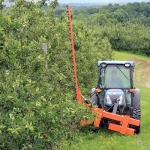Most of the growers have been planting apples following his tall spindle design, and they take every opportunity to learn and refine their techniques of trellis building, feathered tree planting, no heading, limb tying, and renewal pruning. And as Robinson plunges into new territory, they listen and are quick to adopt.
Robinson was the guest of honor during the second annual Ridgefest presented in early August by the Michigan Pomesters and attended by 200 growers. He is the keynote speaker on December 2 at the Washington State Horticultural Association meeting in Wenatchee.
Robinson’s latest idea: In year five, convert those tall spindle orchards into fruiting walls using mechanical hedging in summer to narrow the trees to three feet thick at the base, two feet thick at the top.
A fear, however, is that fireblight could infect the trees through the cut shoots, Robinson said. “I wouldn’t try it in orchards with a history of fireblight.”
Michigan extension fruit educator Phil Schwallier is a strong advocate of Robinson’s tall spindle training system. He convinced the folks at Thome Orchards in Comstock ParkHarold and Joann, their son, Steve, his wife, Missy, and grandson, Mitchto hedge one row of trees on July 1 and another on August 1. The trees are Brookfield Gala in their seventh leaf. Steve admitted to having some doubts, one of which he expressed with an application of antibiotic after hedging “just in case” fireblight might be in the orchard.
They used a double-action (reciprocating) sickle bar hedger developed by Phil Brown Welding, located only about three miles from their orchard.
“You need to do this,” Schwallier told growers about hedging. “This is your future here. Take a good look at it. Everybody will be doing this in the next five to ten years.”
Schwallier and Dr. Ron Perry introduced other Michigan growers to the concept during two field days at the Clarksville Horticultural Experiment Station earlier in the summer. Perry used an ordinary gas-powered, handheld garden hedge pruner to show everybody how easy it was and how quickly results were visible.
Robinson said he was introduced to the hedging concept in Europe about five years ago, but the Europeans don’t have to deal with fireblight, and he was fearful of trying it in the Northeast or the Great Lakes region.
“Studies by Sherm Thomson in Utah showed that the summer heat really slows fireblight down,” Robinson said, and that encouraged him to put trials together in New York. Last winter, Dr. Alberto Dorigoni, a pomologist in Italy’s South Tyrol region, came to Boston for the winter meeting of the International Fruit Tree Association, where he explained his work.
Robinson is convinced U.S. growers are heading in similar directions as those being forced on European growers, the most important factor being the increasing shortage of orchard workers.
Robinson calculates that it takes 500 hours per acre per year to produce a crop, but he thinks growers can get to 200 hours by reducing the time spent pruning. Additional reductions can come from better chemical thinningreducing the need for hand thinningand use of platforms for pruning, thinning, and harvesting.
Using renewal pruning in tall spindle apples makes pruning easier because it’s simple. It involves removing two or three of the largest branches each winter from each tree and making a few clips to simplify the structure. Some summer pruning is needed to improve light penetration.
But with the hedging system, summer pruning is eliminated, and Robinson thinks dormant pruning can be cut back to every other year or even every third year.
Robinson recalled the early days of his career, when growers were experimenting with mechanical hedging in the 1980s. “Dormant-period hedging on semivigorous rootstocks like M.111 led to an explosion of growth,” he said. “It failed miserably and had to be abandoned.”
In the new system, he said, “We start with a good job of dormant pruning and follow with summer hedging, just a mild haircutting to expose the fruit to light without investing much in labor.”
10 reasons to use the tall spindle
Why should growers use the tall spindle apple orchard design system?
Michigan Extension educators Phil Schwallier and Amy Irish-Brown and Denise Ruwersma, a technician at the Clarksville Horticultural Experiment Station, say the system:
- Generates the best early and gross dollar returns
- Is adaptable to mechanization
- Is one of the most efficient and cost-effective systems
- Produces high quality fruit
- Is easy for employees to learn
- Fits growing characteristics of a high-density apple tree
- Maximizes the tree’s ability to capture sunlight
- Has little wasted (shaded) space in a tree
- Maximizes yield per acres because of its height (10 to 11 feet)
- Has a relatively low carbon footprint
Critiques
Robinson, in his perfection of the tall spindle system, has developed a set of rules and goals, and is offering a steak dinner to growers who are able to meet the goal of obtaining a cumulative yield of 3,000 bushels of apples per acre by the end of the fifth leaf. To do that, growers need to harvest 15 to 20 apples per tree in the second leaf.
Two thousand 100-count apples from 1,000 trees give 200 bushels per acre in second leaf. They’ll need to get 400 bushels in third leaf, and 1,200 in the fourth and fifth leaves, to reach 3,000.
The Thomes recorded their production on their Brookfield Galas planted in 2007 on M.9-337 rootstock: They got 100 bushels per acre in 2008, 327 in 2009, 490 in 2010, 1,063 in 2011, 327 in the big freeze year of 2012, and are predicting 1,200 this year.
The Thomes’ trellis posts are about 23 feet apart. They started out at 45 feet but needed to add support. Robinson recommends 30 feet.
Robinson couldn’t criticize the spacing. With trees three feet apart in rows 11 feet apart, the Thomes meet Robinson’s recommendation of alleys no wider than 12 feetfor any reason. A spacing of 3 by 11 feet33 square feet per treeyields a tree population of 1,290 per acre, each capable of producing from one to 1.2 bushels per tree, especially with irrigation, which the Thomes have, and fertigation, which they have yet to implement. One hundred twenty apples per tree would give them 1,548 bushels per acre, a number Robinson thinks growers will be able to make. He’s thinking of raising his five-year yield goal.
Tree training
As the Ridgefest tour moved on to Windy Ridge Orchards, owned by Chuck and Sue Rasch and family, Robinson got a chance to reiterate some of his pruning and training advice in a 2013 planting of Aztec Fuji and Jonastar Jonagold on Geneva 11 rootstock. (Robinson loved the rootstock choice.)
Rasch had chosen to stub back some of the larger feathers on the new trees and tie down others. Tie down everything, cut nothing, Robinson advises, and never head a tree, even if it’s not feathered and is just a whip. Such trees need a rubdown or spray with MaxCel (6-benzyladenine) to induce branching, but should not be headed to induce branching. Either heading back or planting whips will set the grower back a year and won’t win the steak dinner.
“If you invest more time early to bend the branches down, you need do that only once, and you won’t have to intervene for three more years before you need to prune,” he said.
“More tying down means more fruit earlier,” Schwallier added. “Remember that more pruning means less fruit.”
Summer hedging was discussed with a crowd of 200 at Thome Orchards.








Leave A Comment